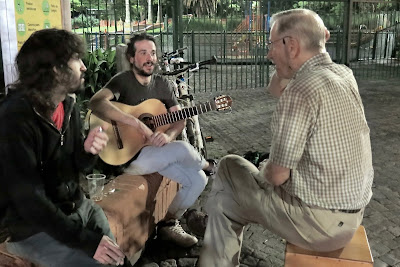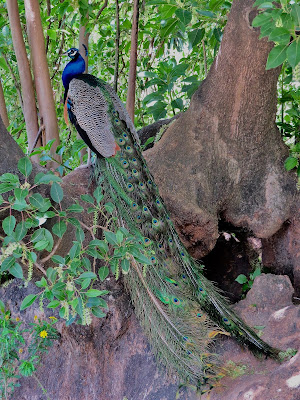I prefer landing in a new city during daylight. Sure, I may have looked at some maps and photos, but when it’s dark one totally misses the lay of the land. Add to this our grogginess after the all-night flight from New York—for a total of 14 hours stuffed in planes—and we felt like a couple of zombies.
We landed at the surprisingly small Buenos Aires airport at 4:30 AM, so thank goodness my brother, Dan, had arranged for us to crash for a few hours at Circus, a rather nice hostel, before checking in to our hotel.
We stayed at the Magnolia Boutique Hotel in Buenos Aires’s vibrant, north-central Palermo neighborhood, walking and cabbing around town to sample the food, culture and natural wonders of this sprawling South-Atlantic-coast capital city of 3,000,000.
From the moment we left the airport terminal, we noticed how appropriate the city’s name, Buenos Aires, or good airs, seems. We remarked on it quite often during our stay, relishing the gentle breezes, low humidity and clean smell of the air. We’d packed for anything from 40s to 70s Fahrenheit, but this was a pleasant surprise: 80s every day and mostly fair skies. I just wished I’d brought more summer shirts.
PARKS & REC
Our first morning we headed for the colorful La Boca, a working-class, ship-yard neighborhood, now better-known for its off-beat shops and restaurants, colorful buildings and street art, and tango-related come-ons at every turn.
Next, we cabbed about five miles back toward Palermo and the Carlos Thays Botanical Gardens, a beautiful 18-acre, triangular park featuring over 5,000 distinct species of plants and a few interesting pieces of sculpture.
Right across the broad Avenida Sarmiento from the botanical garden is the Eco Parque, formerly the Buenos Aires zoo. There we enjoyed the beautiful grounds and spotted a few of the animals allowed to remain there after city government took over its management in 2016. (Alas, well over 100 animals died during the ensuing two years. Another 12 had escaped, 15 freed and 241 transferred somewhere else during this period.)
SHOW ME THE MANI
Before heading back to the hotel, we stopped for a beer and a snack at a pleasant little sidewalk cafe, where my interaction with our server provided one of the many constructive Spanish-language-learning experiences I encountered during our trip—this one worth mentioning for the sheer humor of it.
While Dan was in the men’s room, I asked the young woman if they offered anything to munch on with our beer. She replied, “Money.” I commented how unusual it was that they should charge for the kind of snacks most bars would serve for free. She shook her head and said it again: “money.” No matter what I said—and my Spanish is pretty good—she just kept insisting, “money.” Finally, I just gave up and conceded that we’d be willing to pay.
So she brings our beers, and with them a bowl of peanuts. As she sets them on the table, she points at them and says, “Mani.” And so it dawned on me: the word for peanuts in Argentina isn’t the one used in Mexico, cacahuates. It’s mani.
FINGER FOOD, FLOWERS AND FINE ART
 |
| PHOTO: Dan Willius |
The highlight for me, though, was listening to a couple of young men who were playing guitar and singing, and then striking up a conversation with them in Spanish. They were delightfully open and curious about me and the USA.
 |
| PHOTO: Dan Willius |
Next day we headed back to what I want to call B.A.’s green zone, and spent a couple of hours at the Paseo El Rosedal, a lovely rose garden. The roses, as well as the just-flowering, lavender jacaranda trees reminded us that, while it was getting icy and snowy back home, we were enjoying the Southern Hemisphere’s version of May.
From there it was to the MALBA, or Latin American Art Museum of Buenos Aires. I enjoyed the smaller-than-expected collection on exhibit, especially the more modern works, but it was also fun just watching people.
MEETING EVITA
We then took a brief cab ride to the world-famous Recoleta Cemetery, home, since 1822, to the earthly remains of Argentina’s rich and powerful, including presidents, military brass, Nobel laureates and even a granddaughter of Napoleon.
Recoleta is like a city in miniature, its 6,000-plus elaborate mausolea like so many dark stone buildings looming over narrow streets. Most are decorated with over-the-top classically-influenced sculpture and furnishings.
The color palette runs from mid-gray to dark gray to black. With the exceptions of a few more modern, less somber designs, I found it quite depressing, a bit claustrophobic…though seeing the familia Duarte mausoleum with Eva (Evita) Peron’s always-flower-festooned grave made it all seem worthwhile.
TORTILLINI AND TANGO
Back at the hotel we enjoyed a couple of beers on the tiny enclosed patio of our hotel before heading out for dinner and a taste of Argentine tango.
We dined at Amici Miei, a nice little back-street Italian place in the San Telmo neighborhood, within walking distance of our tango show. The food and wine were excellent, especially enjoying them on what has to be the world’s narrowest—three feet, tops—balcony overlooking the street below.
 |
| PHOTO: Dan Willius |
The tango show, at El Viejo Almacén, proved a delightful surprise. Once again, Dan had managed to avoid a “tour bus” attraction in favor of an authentic taste of Argentine culture as the locals experience it.
Among an intimate audience of about 100 we enjoyed an amazing program comprising fiery, precise tango numbers, songs by what we presumed were once-famous singers, and a rather incongruous set of indigenous flute-and-percussion music we felt to be more representative of Bolivia or Peru than Argentina.
Any question that we might be in a tourist trap evaporated when the entire audience sang lustily along with some of the vocals.
With the music still strumming in our heads we returned to the Magnolia and began packing for our next day’s departure for San Antonio de Areco and the annual gaucho fair.

























No comments:
Post a Comment